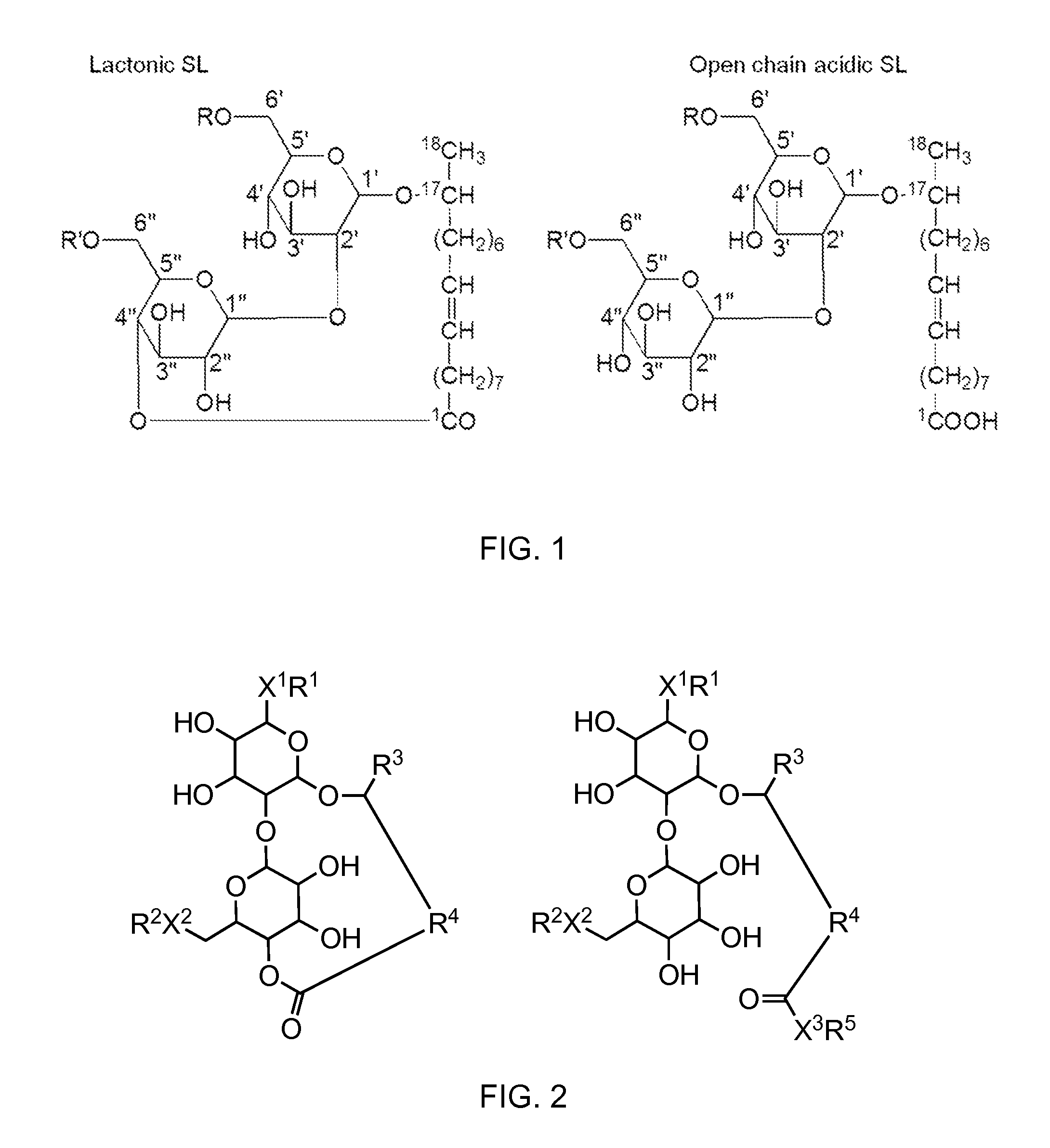Modified sophorolipids combinations as antimicrobial agents
a technology of sophorolipids and sophorolipids, which is applied in the field of modified sophorolipid combinations as antimicrobial agents, can solve the problems of no prior art disclosure, and achieve the effects of enhanced antimicrobial activity, higher activity, and enhanced antimicrobial activity
- Summary
- Abstract
- Description
- Claims
- Application Information
AI Technical Summary
Benefits of technology
Problems solved by technology
Method used
Image
Examples
example 1
Antifungal Activity of MSL Combinations Against Plant Fungal Pathogens
[0056]Antifungal activity of MSL combinations were confirmed by experiment and observations. The compounds used in antifungal assays are 1, 2, 6, 7, and 8. In this assay, MSLs and natural SLs (single component or mixture) were tested individually (i.e., only one MSL) and in combinations (i.e., MSL+MSL or MSL+natural SL) against a panel of 18 different fungi. In all cases mixtures consisted of equal quantities of each component of the mixture (i.e., 1:1 ratio of MSL-X+MSL-Y, w / w). The natural SL (single component or mixture) and MSL samples were dissolved in 5% (w / v) Tween 20 and 5% (w / v) Propylene glycol solution to a final concentration of 10 mg / mL (i.e., 5 mg of MSL-X and 5 mg of MSL-Y) that was used as a stock solution. The stock solution (100 μL) was added into a 96 well microplate and serially diluted from 10 mg / mL to 0.0024 mg / mL using culture medium. The culture media used for antifungal assay include, mine...
example 2
Antibacterial Activity of MSL Combinations Against Plant Bacterial Pathogens
[0057]Bacterial infections in plants are much like the symptoms in fungal plant diseases. Examples are leaf spots, blights, wilts, scabs, cankers and soft rots of roots, storage organs and fruit, and overgrowth. To determine the antibacterial activity of SL-derivatives, 7 different plant pathogenic bacteria were used (Table 4). The compounds used in antibacterial assay are 1, 2, 6, 7, 8, 16. In this assay, MSLs were tested individually (i.e., only one MSL) and in combinations (i.e., MSL+MSL or MSL+natural SL) against a panel of 7 different bacteria. In all cases mixtures consisted of equal quantities of each component of the mixture (i.e.,1:1 ratio of MSL-X+MSL-Y, w / w). Combinations were dissolved in 5% (w / v) Tween 20 and 5% (w / v) propylene glycol solution to a final concentration of 10 mg / mL that was used as a stock solution. The stock solution (100 μL) was added into a 96 well microplate and serially dilut...
example 3
Antibacterial Activity of MSL Combinations Against Biofilm Forming Bacterial Strains
[0058]Similar to plant bacterial and fungal pathogens, microbial (e.g., mold) fouling on painted walls in house, office and storage facilities causes frequent maintenance and unpleasant odor. Marine fouling is a big problem in shipping industry and marine structures such as cooling towers. Biofouling causes significant damage to ships and cooling towers in terms of maintenance time and repair costs. To determine the antibacterial activity of natural or MSLs, 8 different biofilm forming bacteria were used (Table 6). The compounds used in the antibacterial assay are 1, 2, 6, 7, 8 and 16. In this assay, MSLs and natural SLs were tested individually (i.e., only one MSL) against a panel of 8 different biofilm bacteria. MSL samples were dissolved in 5% (w / v) Tween 20 and 5% (w / v) Propylene glycol solution to a final concentration of 10 mg / mL that was used as a stock solution. The stock solution (100 μL) wa...
PUM
| Property | Measurement | Unit |
|---|---|---|
| Length | aaaaa | aaaaa |
| Composition | aaaaa | aaaaa |
| Concentration | aaaaa | aaaaa |
Abstract
Description
Claims
Application Information
 Login to View More
Login to View More - R&D
- Intellectual Property
- Life Sciences
- Materials
- Tech Scout
- Unparalleled Data Quality
- Higher Quality Content
- 60% Fewer Hallucinations
Browse by: Latest US Patents, China's latest patents, Technical Efficacy Thesaurus, Application Domain, Technology Topic, Popular Technical Reports.
© 2025 PatSnap. All rights reserved.Legal|Privacy policy|Modern Slavery Act Transparency Statement|Sitemap|About US| Contact US: help@patsnap.com



